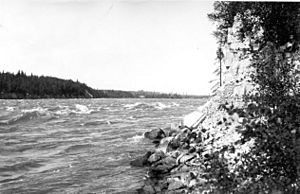Misipawistik Cree Nation facts for kids
Quick facts for kids
Misipawistik Cree Nation
|
|||||||||||||||
|---|---|---|---|---|---|---|---|---|---|---|---|---|---|---|---|

Grand Rapids in 1921
|
|||||||||||||||
| Country | |||||||||||||||
| Province | |||||||||||||||
| Area | |||||||||||||||
| • Total | 16.97 km2 (6.55 sq mi) | ||||||||||||||
| Population
(2011)
|
|||||||||||||||
| • Total | 716 | ||||||||||||||
| • Density | 42.2/km2 (109/sq mi) | ||||||||||||||
| Time zone | UTC-6 (CST) | ||||||||||||||
| Postal Code |
R0C 1E0
|
||||||||||||||
| Area code(s) | 204 | ||||||||||||||
|
|||||||||||||||
The Misipawistik Cree Nation (MCN) is a Cree community in northern Manitoba, Canada. It was once known as the Grand Rapids First Nation. In the local Cree language, Misipawistik means 'Rushing Rapids'. This name came from a famous spot with fast-moving water. This landmark changed when the Manitoba Hydro-electric Dam was built in the late 1950s.
MCN is located near Grand Rapids, Manitoba. It is about 400 kilometres north of Winnipeg. You can reach it by PTH 6. The community sits where the Saskatchewan River flows into Lake Winnipeg. Misipawistik Cree Nation has one reserve, called Grand Rapids 33. It covers an area of about 18.5 square kilometres. The community is led by a chief and three councillors. The current Chief is Heidi Cook. Misipawistik Cree Nation is part of the Swampy Cree Tribal Council. Their main offices are in The Pas.
Contents
History of the Misipawistik Cree Nation
The Misipawistik Cree Nation is a Cree-speaking community. It is located in Northern Manitoba, Canada. The people of Misipawistik are mostly descendants of the Cree people. These Indigenous peoples have lived in the Canadian Shield region for thousands of years. For a long time, Cree people moved to this area during the summer. They later settled here year-round when the North American fur trade began. Cree and mixed-heritage families continued their seasonal travels. This practice lasted until the late 1900s.
Early Travelers and the Fur Trade
Many famous Canadian explorers passed through Misipawistik. They used the waterways to travel to Western Canada before the late 1800s. For example, Pierre Gaultier de Varennes, sieur de La Vérendrye traveled through in 1741. He opened Fort Bourbon there. By the late 1700s, Misipawistik was deeply involved in the North American fur trade. This area was very important for the fur trade. Most water routes into the Northwest met at this spot. During this time, Misipawistik became a year-round home. Both Cree and Métis families lived there. The fur trade gave them a way to live in the area all year.
In the 1800s, the fur trade started to slow down. Other ways of making a living began to appear. Fishing and trapping became important for families. These activities helped them support themselves. This continued well into the 1900s.
Signing Treaty 5
The Cree people of Misipawistik signed Treaty 5 in September 1875. Alexander Morris helped negotiate this treaty. He said it was needed because of new boating technology. It was also important for the economy of the region. In his book, The Treaties of Canada with the Indians of Manitoba and the North-west Territories, he wrote: "The progress of navigation by steamer on Lake Winnipeg, the establishment of Missions and of saw milling enterprises, the discovery of minerals on the shores and vicinity of the lake as well as migration of the Norway House Indians."
The Cree people wanted their reserve lands to be on both sides of the Saskatchewan River. This river flows into Lake Winnipeg. However, they were convinced to accept only the southern shore. The exact reasons for this are still not fully clear.
National Cree Gathering 2007
Misipawistik Cree Nation hosted the 12th annual National Cree Gathering. This was a week-long event. Cree people from all over Canada and the United States came together. They celebrated and shared their traditional practices. They also promoted their unique languages and ways of life.
A key part of the National Cree Gathering is the 'Unity Run'. Young people from many communities take part in this run. They run from the community that hosted the event last year to the next host community. Sometimes, this journey can be over 2000 kilometres long. In 2007, the youth ran from Moose Factory, Ontario to Misipawistik Cree Nation.
Misipawistik Cree Nation Population
Misipawistik has about 716 members. This makes it a smaller community compared to many other First Nations communities. The people living there include Cree, Metis people, and other First Nations people. The two main languages spoken are Cree and English.
Notable Members of the Community
- Ovide Mercredi
- Dr. Marlyn Cook


